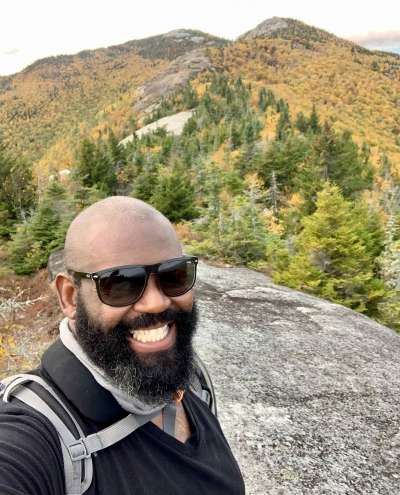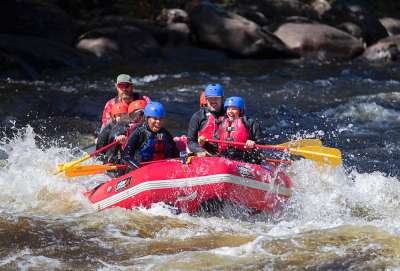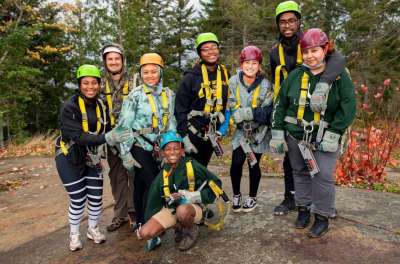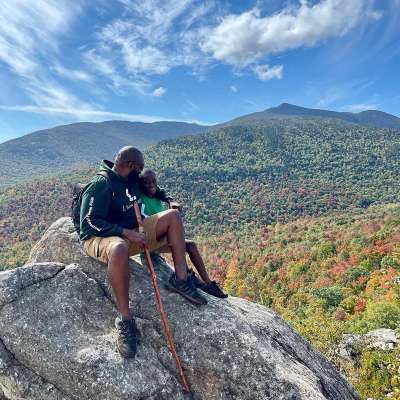As a child growing up in Baltimore, Maryland, Clifton Harcum’s outside recreation was limited to the playgrounds and ballfields of youth sports. It wasn’t until his first job after college that he discovered there was more to the outdoors than sidewalks and mown grass. Now, he thrills at canoeing and camping and hiking tall mountains. For the past two years, Clifton has been the director for the Division of Diversity, Equity and Inclusion at SUNY Potsdam, in the Adirondack foothills. At the college, he’s created Live Now, an organization whose goal is to bring diverse groups of students together to explore the outdoors.
Growing up in Baltimore, we played outside, but there weren’t a lot of green spaces. We had basketball courts outside and little teeny playgrounds and raced up and down alleys. I played on sports teams growing up. But my family never explored state parks or other outdoor places.
I went to the University of Maryland Eastern Shore, a HBCU (Historically Black Colleges and Universities) which is in a rural area, with trees and woods. But as student – I guess because of some of my fears of the outdoors – I never really explored the area. I ended up working at the university after graduation, and that’s when I started to go outdoors. That was a result of planning trips for students at the college to get them out of their comfort zones, get involved in leadership development and community outreach.
On one of these trips, we took a group of students camping and stayed in a cabin in the middle of the woods, with no cell phone reception. It was something different for all of us, because most of the students who came to the school were from Baltimore, D.C., inner-cities, where those things aren’t part of the culture of what most people do. We had a ball – walking through the woods, cooking outside, canoeing. It just became something I fell in love with – doing things I’d never done before, and overcoming fears and being exposed to something I didn’t know existed. Before then, I didn’t feel like that was a space for me. A lot of people in my community growing up just assumed that sort of thing was for well-off white people.
I worked for the University of Maryland Eastern Shore for about 13 years, and that’s where I came up with the idea of Live Now. I decided I really wanted to do something different with my career. I was a 9-to-5 director, and they wanted me to wear a suit and tie every day. And I had this hunger for the outdoors. I thought, “I want to live, I want to live now. Why am I waiting to do these things?” I wanted to move to a place where that’s what I could do all the time professionally. I looked at different places, like Colorado, Hawaii, places that were more outdoorsy and natural. And I stumbled upon Jefferson Community College in Watertown, New York. They advertised walking trails and campsites and different things close to the college. So, I took a job there and took full advantage of those amenities.
One of my colleagues there was from the area, and he took me out camping, whitewater rafting. My colleagues used to tell me that I needed to go to the Adirondacks. But from Watertown, the Adirondacks were about three hours away. Then I took a job at SUNY Potsdam in 2019 and lived in Saranac Lake, which is right in the Adirondacks. I started meeting different people, being exposed to different things. And that’s what I love.
I moved here to get outdoors, but sometimes that was still scary. The area I was living in was predominately white. And up north, believe it or not, you drive through some of these rural places, and you see Confederate flags. You’re in the middle of nowhere, and you see symbolism like that, it makes you feel uneasy. I was scared to go into the woods.
When the pandemic hit, I started jogging. That kind of got boring, so I decided I was going to start jogging in the woods. It was hard, I was scared a lot. I turned around a lot of times. But I made up my mind I wanted to do this. I needed a stress release. Once, I was on a hike by myself and got scared and turned around and headed back down. There was a white guy coming up, and I really felt determined that I needed to reach the summit. So I asked this guy if he would mind hiking with me to the summit. We didn’t know each other, we’re in the middle of the woods by ourselves, and we just started talking. We made it to the summit, and I was just so proud of myself – that I’d overcome my fears and done something that I’d moved here to do.
After that, it was one hike after another. I’ve hiked over 40 mountains and completed several hiking challenges since then – the Lake Placid 9er, the Saranac 6er, Tupper Lake Triad. The challenges really encourage me. I was able to explore different parts of the region. I’ve been a lot of places I would have never known because of these challenges. With the challenges, if you want to complete them, you go where you need to go. On my to-do list is to complete the Adirondack 46er challenge, which is reaching the 46 highest peaks in the Adirondacks. I feel like if I can complete that, that’s the real deal.
At SUNY Potsdam, I oversee the Center for Diversity. We want to create a community for students from underrepresented communities – students who come from all different identities – to create a space for them to be themselves and gain experiences, have a good time and feel welcomed while they’re here in the North Country region. A lot of our students who get involved with the Center for Diversity come from inner cities – Brooklyn, Harlem, Bronx. They grew up in cities like I did. In the inner cities, even the parks – they’re safe for some, but they’re not always safe for everyone. So there are various fears there.
When you’re not involved in the outdoors as a young person, that’s not part of your cultural identity or something you’re comfortable with. I really wanted to share the opportunities I’ve had with students. When you come from out of town and you go to a new school, you really don’t know what’s around you. I felt like, as a black faculty person at the university, it’s my obligation to expose them to what’s around them, to engage them and provide access to the amenities that we have up here.
Live Now is a way to get students exposed to the outdoors, but also pique their interest in going into environmental studies or outdoor recreation careers. The ultimate goal is to foster togetherness and provide experiential learning opportunities for students in this region. When we take these trips, we’re being educated about the region, plant life, mountains, history. The students are getting education as well as recreation. We have about 100 students so far who have participated in our Live Now activities.
We’ve taken students on the Raquette River to canoe, out to Lake Placid for mini golf, hiking, whitewater rafting, and just recently we took students to the Experience Outdoors for a high ropes course and ziplining, and it was wonderful. Life changing. When I’m organizing these activities, I’m looking at the social aspect, but also what it’s doing for people internally – overcoming fears, challenging yourself, building these shared experiences and relationships with people, and getting exposed to things that broaden your world view and how you look at yourself. It’s multifaceted.
It’s really a mindset, a way of approaching life. Like our motto says, “Why wait until tomorrow? Live Now!” So, really tackling life head on. Carpe Diem. It’s about changing how you think about possibilities for your life, and not waiting and making up excuses. There’s this fear of the unknown, but also the excitement that you’re in it and you’re able to do it, that adrenaline rush once you’re doing it. When we took students whitewater rafting, only one of the students knew how to swim. When we took students canoeing, none of them knew how to swim. When we took students on a hike in the mountains, none of them had hiked a mountain before.
It’s doing so much – boosting confidence, the excitement of it, the awe of the beauty, lessening of stress. All the things anyone feels doing this sort of thing. When you’re a person of color and you’re doing these activities that you’ve never done. It makes you feel like, “Man, I’ve been missing out on life.” And you want more of it. We’re planning ski lessons, snow tubing, snowshoeing, cross-country skiing. We’re planning a lot of things that I had never done before I came up here, and the majority of the students haven’t either.
We’re creating opportunities. They go back home and they tell their friends and family, and now, they’re creating community. They’re encouraging other people to do these things, too. So now we’re getting more people to do these activities that traditionally they would have never even thought about doing. We can relate to each other as a culture.
The majority of students participating in Live Now are BIPOC, but we also have white students – a lot of different people come together on these trips. As the director for the Center for Diversity, I think a lot of the issues that come about in our communities when it comes to race happen because people don’t communicate or hang out with each other enough to understand our commonalities. These opportunities are also a way for people to come together in a social space and get to know one another and see our similarities instead of looking at our differences. I believe we can do a lot better if we communicate and interact with one another more outside of work or school.
When you don’t see anyone who looks like you out there, that makes a difference. I hike a lot in the Adirondacks, and in all of my time hiking, I can probably count on two hands how many people I’ve seen who aren’t white. You might, rarely, see someone one who is Asian-American or Indian-American. But I don’t really ever see any African Americans out there. It’s just good to see somebody who looks familiar. The people that I’ve met in outdoor spaces, they’ve been great – very friendly and welcoming. It’s a great community. But it would be great to see more people like me out there. We’re missing out on some things that would be very beneficial to our overall health and our outlook on life. This is true of hiking or camping, being on the water, visiting ski areas.
I believe that in order to diversify outdoor spaces, we need to develop programs in our K-12 school system – basically, similar to how Live Now operates, adding on educational aspects, so students are going outside and learning by having fun. I think that’s how you create a culture of people who enjoy the outdoors and where it becomes a norm. My son and my daughter – when we were in Maryland, we didn’t have trails like they have here, but we went outdoors. I had them on walking trails, canoeing with me. If you start kids off early, it becomes comfortable for them. When I was scared to go hiking in the mountains, my son was having a ball hiking and jumping around.
I love to do anything outdoors – camping, swim in the lakes, swim in the rivers, hike, anything that’s going to take me out of my comfort zone and give me an experience that I never thought I would have. Being outdoors, you can feel at peace. It’s a place where you can really reflect and kind of let all the negativity and stress off. It’s a place of healing as well. I used to call it my sanctuary. I’d hike three or four times a week, but every Sunday was special. It allowed me to feel at one with nature, with God, and just see the natural beauty of earth. It’s an incredible feeling.






Discussion *